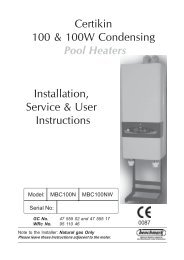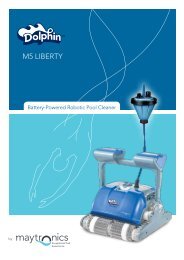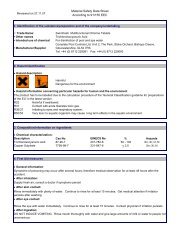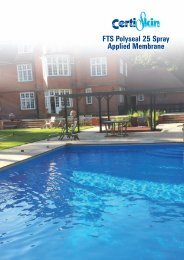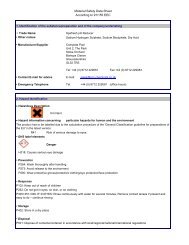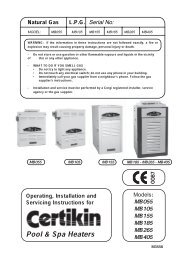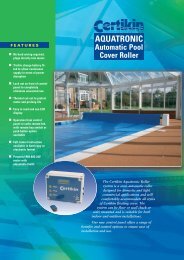Pooltest - Swimming Pools
Pooltest - Swimming Pools
Pooltest - Swimming Pools
Create successful ePaper yourself
Turn your PDF publications into a flip-book with our unique Google optimized e-Paper software.
ERROR MESSAGES<br />
The Palintest 3 Photometer displays error messages to<br />
assist the operator in the event of any problems with the<br />
sample or instrument.<br />
Display Cause Action<br />
E1<br />
Coloured, dirty or<br />
scratched BLANK tube<br />
used.<br />
E2 or E3<br />
E4<br />
E5<br />
a) Incorrect BLANK used<br />
to zero instrument.<br />
b) Electrical fault in instrument.<br />
Battery voltage too low<br />
for correct reading.<br />
Stray light has affected<br />
the reading.<br />
Re-zero instrument on a correct<br />
BLANK in a clean, dry tube.<br />
a) Re-zero instrument on a correct<br />
BLANK.<br />
b) Return instrument for repair.<br />
Change batteries.<br />
a) Remove instrument from<br />
vicinity of spotlights or other<br />
bright light sources.<br />
b) Check instrument case for damage.<br />
CALIBRATION CHECK<br />
Certified colour standards are available for checking<br />
instrument calibration. Use only Series M2 Standards.<br />
Instrument calibration should not change in use.<br />
CARE AND MAINTENANCE<br />
Here are five hints on keeping the photometer clean, free<br />
from contamination and in good working order :-<br />
1 Prepare you workplace before use. Make sure you have sufficient<br />
space to work in and all the necessary reagent systems.<br />
2 Wipe test tubes on a clean tissue to remove drips or condensation<br />
before placing in the photometer. Remember to cap the<br />
tube before reading in the instrument.<br />
3 Immediately wipe up any drips or spillages onto the<br />
instrument or into the test chamber with a clean tissue.<br />
4 Keep the instrument in a clean, dry place when it is not in<br />
use. Keep it on a clean, dry bench away from chemicals,<br />
place it in a storage cupboard or keep it in a carrying case.<br />
5 Keep the carrying case in a clean, dry condition. Make sure any<br />
solutions that have spilled or drained into the carrying case are dry<br />
before the case is closed up and the instrument is put away.<br />
Replace the battery when the 'B' symbol remains on the display. To<br />
remove the battery compartment cover press gently on the sides of<br />
the cover and pull downwards. Use 2 x 1.5v alkaline 'AA' batteries,<br />
MN 1500, LR6, E91, AM3 or equivalent. Remove batteries from<br />
instrument if it is to be stored or left unused for a long period of time.<br />
The <strong>Pooltest</strong> 3 Photometer is guaranteed for a period of two years<br />
from the date of purchase excluding accidental damage or damage<br />
caused by unauthorised repair or misuse. Should repair be necessary,<br />
contact our Technical Services Department quoting the instrument<br />
serial number. This guarantee does not affect statutory rights.<br />
An instrument failure, due to test cell contamination, is not covered<br />
by the Palintest instrument warranty.<br />
TECHNICAL SPECIFICATION<br />
Instrument Type Single beam colorimeter preprogrammed<br />
for direct reading of<br />
chlorine residual, pH and cyanuric acid.<br />
Optics<br />
Palintest M2 optical system with pulsed<br />
blue-green LED, wavelength filter and<br />
photodetector<br />
Operating Ranges Chlorine 0.00 - 5.00 mg/l<br />
pH 6.80 - 8.40 mg/l<br />
Cyanuric Acid 0 - 100 mg/l<br />
Operating Temp 0 – 40°C/32 – 104°F<br />
Display<br />
10 mm character LCD<br />
Test Cells For use with round test tubes 10 ml, 20<br />
mm OD, 18 mm path length<br />
Operation<br />
Blank/Zero Setting<br />
Two-button operation<br />
Optionally held in memory or reset for<br />
each reading<br />
Internal Calibration Factory set. Recalibration through<br />
internal software<br />
Instrument Case<br />
Power Supply<br />
Size<br />
Splash-proof case with membrane<br />
keypad<br />
2 x 1.5v batteries. Power management<br />
system with auto-switch off<br />
Instrument only 173 x 75/44 x 41 mm<br />
________________________<br />
For more information about Palintest products,<br />
visit our web site at www.palintest.com<br />
V2-01/09<br />
Palintest<br />
<strong>Pooltest</strong><br />
_____________<br />
PHOTOMETER<br />
®<br />
3<br />
PRECISION PHOTOMETER FOR<br />
MEASURING CHLORINE, pH AND<br />
CYANURIC ACID<br />
<strong>Pooltest</strong><br />
PHOTOMETER<br />
3<br />
SERIES M2 OPTICAL SYSTEM<br />
• Simple to use<br />
• Auto-zeroing<br />
• Zero setting held in memory<br />
• Error message display<br />
• Hand-held or bench use<br />
Ranges<br />
Chlorine 0.00 – 5.00 mg/l<br />
pH<br />
6.80 – 8.40 mg/l<br />
Cyanuric Acid 0 – 100 mg/l<br />
Palintest Ltd<br />
Palintest House, Kingsway, Team Valley, Gateshead, Tyne & Wear England NE11 0NS<br />
Tel: 0191 491 0808 Fax: 0191 482 5372 E.Mail: palintest@palintest.com<br />
Palintest is a registered trademark of Palintest Ltd<br />
INST.17
OPERATION INSTRUCTIONS<br />
Blank and Sample Tubes<br />
The <strong>Pooltest</strong> 3 uses a BLANK tube to set the instrument to<br />
zero and a SAMPLE tube to take the test measurement.<br />
A BLANK tube is a test tube filled with untreated water sample.<br />
A SAMPLE tube is a test tube containing the sample to which<br />
reagents have been added in accordance with the test<br />
procedure described opposite.<br />
The zero setting is held in memory. It is not necessary to reset<br />
the zero each time a reading is taken or between different<br />
types of test provided the conditions of use are the same. The<br />
zero setting can be confirmed if necessary by taking a test<br />
reading on the blank tube.<br />
To Select Test<br />
1 Press the MENU key. The currently selected test range will<br />
appear on the display :-<br />
Chlorine<br />
pH<br />
Cyanuric Acid<br />
CL<br />
PH<br />
CYA<br />
2 To change the test selected, press the MENU key until the<br />
required test appears on the display.<br />
To Set Zero<br />
1 Insert the BLANK tube into the test chamber.<br />
2 Press and hold down the ON key until the ‘---‘ symbol<br />
appears on the display (2 seconds).<br />
3 Release the ON key when the display shows ‘0.0’. This<br />
zero setting will be held in memory.<br />
To Take Test Reading<br />
1 Insert the SAMPLE tube into the test chamber.<br />
2 Press the ON key until the test range indication appears on<br />
the display (1 second). Release the key and the test result<br />
will be displayed. (Do not hold the key down or the<br />
instrument will attempt to blank on the sample and cause<br />
errors in the readings).<br />
The test reading for the sample will be displayed.<br />
DPD CHLORINE TEST<br />
Reagents and Equipment<br />
Palintest DPD No 1 Tablets – Photometer Grade<br />
Palintest DPD No 3 Tablets – Photometer Grade<br />
Round Test Tubes, 10 ml glass (PT 515)<br />
Test Instructions<br />
1 Rinse test tube with sample leaving two or three drops of<br />
sample in the tube.<br />
2 Add one DPD No 1 tablet, crush tablet and then fill the<br />
test tube to the 10 ml mark. Mix to dissolve tablet.<br />
3 Take photometer reading immediately. The reading<br />
represents the free chlorine residual as milligrams per<br />
litre (parts per million). Stop the test at this stage if only<br />
free chlorine determination is required.<br />
4 If it is desired to measure combined or total chlorine<br />
residual, continue the test on the same test portion. Add<br />
one DPD No 3 tablet, crush and mix to dissolve.<br />
5 Stand for two minutes to allow full colour development.<br />
6 Take photometer reading. The reading represents the<br />
total chlorine residual as milligrams per litre (parts per<br />
million).<br />
7 The combined chlorine residual is obtained by<br />
subtracting the free chlorine residual result from the total<br />
chlorine residual result :-<br />
Combined Chlorine = Total Chlorine – Free Chlorine<br />
Note that a too high chlorine level (above 10 mg/l) can<br />
cause bleaching of the pink coloration formed in the DPD<br />
test and give a false negative result. If a colourless test<br />
solution is obtained when chlorine is known to e present,<br />
check for the possibility of bleaching by repeating the test<br />
on a sample diluted with chlorine-free water.<br />
Standard Methods<br />
The DPD method is a published Standard Method in the<br />
UK, the European Community, the USA and in many other<br />
countries. The Palintest DPD free and total chlorine tests<br />
are approved by the USEPA as accepted versions of the<br />
Standard Method 4500-C1-G.<br />
pH PHENOL RED TEST<br />
Reagents and Equipment<br />
Palintest Phenol Red Clear Tablets – Photometer Grade<br />
Palintest Photometer<br />
Round Test Tubes, 10 ml glass (PT 515)<br />
Test Instructions<br />
1 Fill test tube with sample to the 10 ml mark.<br />
2 Add one Phenol Red tablet, crush and mix to dissolve.<br />
3 Take photometer reading. The reading represents the pH<br />
value of the sample.<br />
Ionic strength, temperature and other water factors may<br />
have an effect on pH readings. The test has been calibrated<br />
for conditions most likely to be encountered in a typical<br />
swimming pool.<br />
The colour range of the phenol red test is yellow, through<br />
orange to red. The formation of an intense purple coloration<br />
shows that the indicator has been affected by high chlorine<br />
or other disinfectant residuals. In such cases the result<br />
should be disregarded.<br />
CYANURIC ACID TEST<br />
Reagents and Equipment<br />
Palintest Cyanuric Acid Tablets – Photometer Grade<br />
Palintest Photometer<br />
Round Test Tubes, 10 ml glass (PT 515)<br />
Test Instructions<br />
1 Fill test tube with sample to the 10 ml mark.<br />
2 Add one Cyanuric Acid tablet and allow to disintegrate for<br />
at least two minutes. A cloudy solution indicates the<br />
presence of cyanuric acid.<br />
3 Crush any remaining undissolved tablet and mix to ensure<br />
uniformity.<br />
4 Take photometer reading. The reading represents the<br />
cyanuric acid concentration of the samples as milligrams<br />
per litre (parts per million).<br />
The range of the cyanuric acid test is 0 – 100 mg/l. Higher<br />
levels can be tested by first diluting the sample with mains or<br />
deionised water and then applying the appropriate dilution<br />
factor. Palintest Dilution Tube (PT 512), which is available<br />
as an optional extra, should be used for making the dilution.




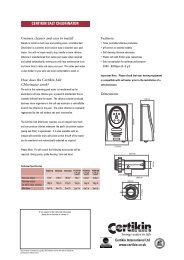
![314 MSDS - Swimfresh Calcium Hardness In[...]](https://img.yumpu.com/49910507/1/190x245/314-msds-swimfresh-calcium-hardness-in.jpg?quality=85)

